®
Space Shuttle ATLANTIS
04544-0389 ©2013 BY REVELL GmbH. A subsidiary of Hobbico, Inc. PRINTED IN GERMANY
Space Shuttle ATLANTIS Space Shuttle ATLANTIS
Als sich die NASA 1969 zum Aufbau und Betrieb einer Raumstation entschloss, sollte für den
Transfer von Menschen und Material ein wiederverwendbares Transportsystem geschaffen
werden. Neben den beiden Feststoffraketen und dem Treibstofftank für den Start galt es,
einen flugzeugähnlichen Orbiter, geeignet für den Wiedereintritt in die Erdatmosphäre und
die Landung, zu entwickeln. Das Shuttle, konstruiert und produziert von Rockwell
International im kalifornischen Palmdale, ist eines der aufwändigsten technischen Geräte, die
je gebaut worden sind. Die Grundstruktur besteht aus Aluminium und einigen Titan-
Elementen. Um den enormen thermischen Belastungen beim Eintritt in die Erdatmosphäre
widerstehen zu können, sind als Außenhülle spezielle Kacheln und Fliesmatten entwickelt
worden. Die Raumfähre “Atlantis”, benannt nach dem ersten US-amerikanischen ozeanogra-
phischen Forschungsschiff Atlantis, hatte ihren Jungfernflug ins All im Oktober 1985. Nach der
“Enterprise “, der “Columbia” und der “Challenger “ fertiggestellt, war sie rund 3 Tonnen
leichter als ihre Vorgänger. Ab 1995 versorgte sie die russische Raumstation “Mir” für zwei
Jahre. Danach rüstete Rockwell den Orbiter mit digitalen Anzeigegeräten im Cockpit, einem
Bremsschirm, einem verbesserten Hitzeschutzschild sowie neuen Computern, Kabeln und
Leitungen aus. Am Ende ihrer letzten Mission vom 8. bis 21. Juli 2011 setzte die Fähre nach 25
aktiven Jahren und 33 Flügen mit rund 193.000.000 Kilometern Flugstrecke planmäßig auf der
Landebahn 15 des Kennedy Space Centers in Florida auf. Sie brachte das Transportmodul
Raffaello von der “International Space Station” (ISS) zur Erde zurück. Mit ihrer Landung ende-
te die Ära der Shuttleflüge. Die Kosten einer Mission lagen zum Schluss bei 775 Millionen
Dollar. Die “Atlantis” wird als Museumsstück im Besucherzentrum des Kennedy Space Centers
in Florida verbleiben. Die einzigartige Besonderheit der Raumfähren bestand darin, dass man
mit ihnen große Objekte und 7 bis 8 Astronauten zur Erde zurückbringen konnte. Das Hubble-
Weltraumteleskop wurde 2009 mit STS-125 zum fünften Mal zu Reparaturen angesteuert. Die
meisten STS-Missionen galten anteilig der wissenschaftlichen Forschung. Es wurden
Experimente an Bord von der Crew betreut oder vollautomatische Labor-Satelliten ausgesetzt.
Mit mehr als 36 Shuttle-Flügen seit 1998 konnte der Aufbau der ISS fertiggestellt werden.
Dank des Roboterarms war eine direkte Montage an die Station aus der Ladebucht heraus
möglich. Nach dem Verlust der “Challenger“ 1986 und der “Columbia” 2003 führte die NASA
bis zur Einstellung des Shuttle-Programms 2011 mit der “Discovery“, der “Atlantis“ und der
1992 fertiggestellten “Endeavour“ insgesamt 133 bemannte Missionen durch. Die “Discovery“
ist seit April 2012 im “Steven F. Udvar-Hazy Center” in Washington, DC. ausgestellt. Die
“Endeavour“ wurde dem “California Science Center” in Los Angeles übergeben. Das „Intrepid
Sea, Air & Space Museum“ in New York erhielt die “Enterprise” als Museumsstück.
Technische Daten:
Länge: 37,24 m
Höhe: 17,2 m
Spannweite: 23,79 m
Tragfläche: 249,9 qm
Rumpfbreite: 5,20 m
Nutzlastbucht (Länge x Durchmesser): 18.38 x 4.57 m
In 1969 when NASA decided to build a working space station, they needed to be established
a re-usable transport system for the transfer of men and materials into space. Apart from the
two solid rocket boosters and a fuel tank required for the take-off, they needed to develop
an air-plane like orbiter suitable for re-entry into Earth’s atmosphere and a conventional lan-
ding. The Shuttle, designed and manufactured by Rockwell International in Palmdale,
California, is one of the most elaborate technical devices that has ever been built. The basic
structure is manufactured of aluminium and some titanium elements. The outer shell was desi-
gned using special tiles and heat resistant mats in order to withstand the enormous thermal
loads during entry into the Earth’s atmosphere. The space shuttle “Atlantis”, named after the
first U.S. Oceanographic Research Vessel “Atlantis”, undertook its maiden flight into space in
October 1985. Completed after the “Columbia” and “Challenger”, the “Enterprise” was around
3 tons lighter than its predecessors. It re-supplied the Russian space station “Mir” for two years
after 1995. Later, Rockwell fitted the Orbiter with digital display systems in the cockpit, a drag
chute, an improved heat shield as well as new computers, cables and conduits. At the end of
its final mission between 8th and 21st July 2011 and after 25 years of active service, the Space
Shuttle landed as planned on runway 15 at the Kennedy Space Centre in Florida with 33
flights and a total of about 193 million kilometres “on the clock”. She brought the Raffaello
Transport Module from the “International Space Station” (ISS) back to Earth. With this landing
the Shuttle Flight Era came to an end. The cost of a mission finally totalled 775 million dollars.
The “Atlantis” will remain in Florida as a museum exhibit in the Visitor Centre at the Kennedy
Space Centre. The unique feature of Space Shuttles was that they could bring large objects
and 7-8 astronauts back to Earth. In 2009, STS-125 headed for the Hubble Space Telescope for
the fifth time to enable repairs. Most STS Missions were based pro-rata on scientific research.
Experiments were conducted by the crew on board or externally by fully automated deploy-
ed laboratory satellites. Construction of the ISS was completed with more than 36 Shuttle
flights since 1998. Thanks to the Shuttles Robot Arm parts could be mounted on the ISS direc-
tly from its cargo bay. After the loss of the “Challenger” in 1986 and the “Columbia” in 2003,
NASA conducted a further 133 manned missions with the “Discovery”, the “Atlantis” and the
1992 completed “Endeavour” until the Shuttle Programme was terminated in 2011. The
“Discovery” has been on display at the “Steven F. Udvar-Hazy Centre” in Washington, DC since
April 2012. The “Endeavour” was presented to the “California Science Centre” in Los Angeles.
The “Intrepid Sea, Air & Space Museum” in New York received the Shuttle “Enterprise” as a
museums exhibit.
Technical Data:
Length: 37,24 m (122ft 2ins)
Height: 17,2 m (56ft 5ins)
Wingspan: 23,79 m (78ft 0ins)
Wing Area: 249,9 qm (2689 sq.ft)
Fuselage Width: 5,20 m (17ft 0ins)
Cargo Hold (Length x diameter): 18,38 (60ft 4ins) x 4,57 m (15ft 0ins)
Empty Weight: 68 tons
Leergewicht: 68 t
Nutzlast: 25,4 t (max.), 16,4 t (für ISS)
max. Startgewicht: 109 t
Haupttriebwerke: 3 x 234 t Schubleistung
Zuladung Treibstoff: 15 t
Bremsschirm-Durchmesser: 12 m
Payload: 25,4 tons (max.), 16,4 tons (for ISS)
max. Take-off Weight: 109 t
Main Engines: 3 x 234 t Thrust
Fuel Capacity: 15 t
Break Chute Diameter: 12 m (39ft 4ins)


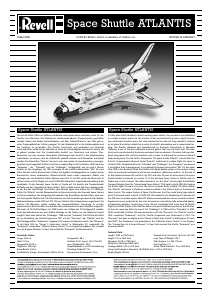

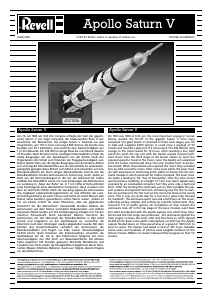
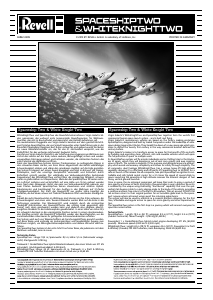
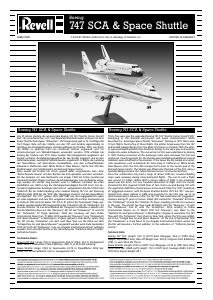
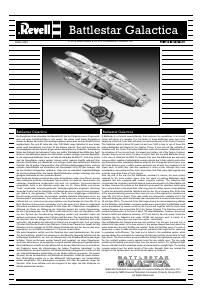
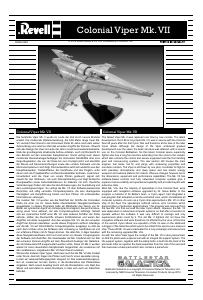
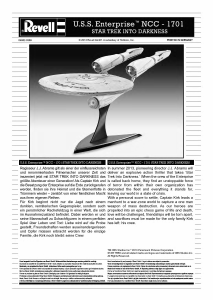
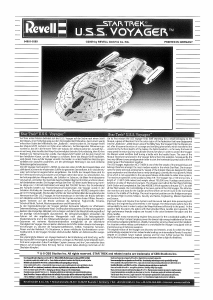
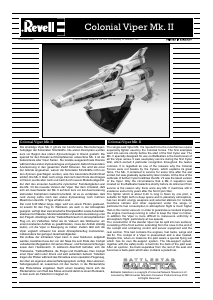
Joignez-vous à la conversation sur ce produit
Ici, vous pouvez partager ce que vous pensez du Revell set 04544 Space and Scifi Space shuttle Atlantis. Si vous avez une question, lisez d’abord attentivement le mode d’emploi. La demande d’un mode d’emploi peut être effectuée en utilisant notre formulaire de contact.